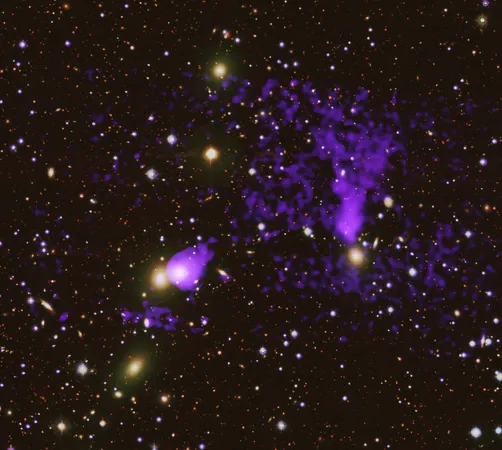
Unveiling Cosmic Drama: NASA's Chandra Discovers Galaxy Cluster with Crossing Streams of Superheated Gas!
2024-09-19
Author: Wei
Sensational Discovery by NASA's Chandra X-ray Observatory
Astronomers have made a sensational discovery using NASA's Chandra X-ray Observatory, revealing a breathtaking cosmic phenomenon: a galaxy cluster where two streams of superheated gas intersect. This striking finding suggests that such crossings could play a pivotal role in the formation of new cosmic structures.
Focus on Zwicky 8338
The focus of this groundbreaking research is the galaxy cluster known as Zwicky 8338 (Z8338), located approximately 670 million light-years from Earth. Within this cluster, scientists uncovered an enormous, comet-like tail of hot gas stretching over an astonishing 1.6 million light-years behind one of the galaxies. This tail was formed as the galaxy was stripped of some of its gas due to its high-speed movement through an ocean of hot gas.
Second Pair of Gas Tails
Remarkably, this is the second pair of gas tails identified in this chaotic cluster. Earlier, astronomers had detected a shorter pair trailing behind a different galaxy. The newly discovered, longer gas tail became visible only through a more in-depth observation using Chandra, which allowed for the detection of the faint X-rays emitted by this high-energy phenomenon.
Crossing Streams
In an exciting twist, evidence now suggests that the gas streams behind these rapidly moving galaxies have crossed paths. The Z8338 galaxy cluster is a tumultuous environment teeming with galaxies, superheated gas, and shock waves reminiscent of sonic booms produced by supersonic jets. This remarkable setting is the aftermath of two galaxy clusters colliding, ultimately giving birth to the Z8338 formation.
Stunning Visuals and Implications
The composite image produced from this observation is a feast for the eyes, showcasing X-ray data from Chandra in vibrant purple, which highlights the multimillion-degree gas that far outweighs the total mass of the galaxies in the cluster. The individual galaxies themselves are captured in an optical image from the Dark Energy Survey conducted at the Cerro Tololo Inter-American Observatory in Chile.
The Key Tail
The key tail, which originally measured about 800,000 light-years, can be seen as a vertical streak in the images. It is believed that the gas in this tail is being stripped from a large galaxy as it races through the cluster's superheated environment. The head of this tail is represented by a cooler gas cloud located around 100,000 light-years from the galaxy that lost it. Intriguingly, the tail has also split into two distinct parts.
Potential for Star Formation
Researchers suggest that the tail’s detachment from the large galaxy could have been triggered by the interaction with the longer tail crossing its path. This crossing of streams might have quite literally pulled the gas away, leading to the formation of a separate structure.
Conclusion: Cosmic Drama Unfolding
This captivating research sheds light on the processes surrounding the detachment and the potential destruction of cooler gas clouds, much like the one at the head of the detached tail. These clouds may continue to exist for at least 30 million years after their separation, providing a fertile ground for the birth of a new generation of stars and planets.
With its stunning visuals and groundbreaking implications, this cosmic drama continues to intrigue scientists and stargazers alike. Who knows what other secrets the universe is hiding, waiting for us to discover? Keep watching the skies, as the cosmic story unfolds!

 Brasil (PT)
Brasil (PT)
 Canada (EN)
Canada (EN)
 Chile (ES)
Chile (ES)
 Česko (CS)
Česko (CS)
 대한민국 (KO)
대한민국 (KO)
 España (ES)
España (ES)
 France (FR)
France (FR)
 Hong Kong (EN)
Hong Kong (EN)
 Italia (IT)
Italia (IT)
 日本 (JA)
日本 (JA)
 Magyarország (HU)
Magyarország (HU)
 Norge (NO)
Norge (NO)
 Polska (PL)
Polska (PL)
 Schweiz (DE)
Schweiz (DE)
 Singapore (EN)
Singapore (EN)
 Sverige (SV)
Sverige (SV)
 Suomi (FI)
Suomi (FI)
 Türkiye (TR)
Türkiye (TR)
 الإمارات العربية المتحدة (AR)
الإمارات العربية المتحدة (AR)